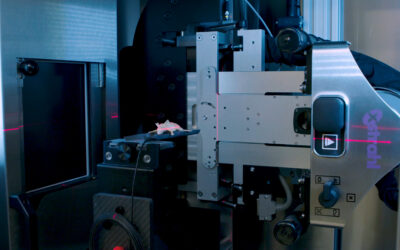Introduction
The aim of this study was to perform the commissioning and acceptance tests of the commercial small animal radiation research platforms Xsthral XenX irradiator.
Methods
The Xstrahl-Xenx irradiator contains an X-ray tube with potentials of 20–220 kVp range. The inherent filtration of X-ray tube is 0.8 mm (Be). An additional filtration of 0.15 mm (Cu) is used in irradiation mode, and additional filtration of 1 mm (Al) is used for imaging. The source-to-axis (SAD) distance is 35 cm. Absolute dose were determined for the largest field without collimator (10 × 10 cm2) following the recommendation of AAPM TG61 protocol using in air method to determine the dose-to-water at the surface of a water phantom for orthovoltage X-ray tubes. These measures were performed with an ion chamber and a calibrated dosimeter (PTW −31013). Absolute dose for small field (10 × 10 mm2) was determined using radiochromic films (Gafchromic EBT3). A calibration curve was fit to characterize the change in optical density (OD) in function of dose using mean intensities read from the red color channel. Films were irradiated with dose range from 0.5 Gy to 9 Gy. Then, films were scanned in transmission mode (positive mode), 48 bits RGB (16 bits per channel color), and 72 dpi resolution. In addition of dosimetric acceptance, other physics measurements were performed. These include measuring the beam homogeneity in the in-plan and cross-plane direction using film for large and small field. Other measurement such as reproducibility of tube voltage, dose output, accuracy of kVp, mA, time, and half value layer have been carried out.
Results
X-ray tube output and reproducibility for kilovoltage (difference between the measured and displayed value), dose output were performed five times. Reproducibility of kiloVoltage was ranged from −1.7% to 1%, of dose was lower than 0.1%. The maximum dose rate at SAD was 278 cGy/min for large filed without collimator and determined using an ion chamber, for small field it was 256 cGy/min and determined using gafchromic films after calibration. Homogeneity of radiation field was 6.5% and 5.4% in cross plan and in plan profile for large field. Homogeneity is better for small field with a collimator, 2.5% and 2.4% in cross plan and in plan profile respectively.
Conclusions
The acceptance tests and calibration of Xsthral XenX platform provide to researchers a tools to estimate doses delivered during irradiation of cells and mice in order to advance research in radiobiology. The dose calculation tool allowed us to performed RILA (Radiation-induced lymphocyte apoptosis) test from linac to Xenx irradiator.
D. Adel, M. Brengues, L. Bedos, D. Azria, P. Fenoglietto & N. Aillères







